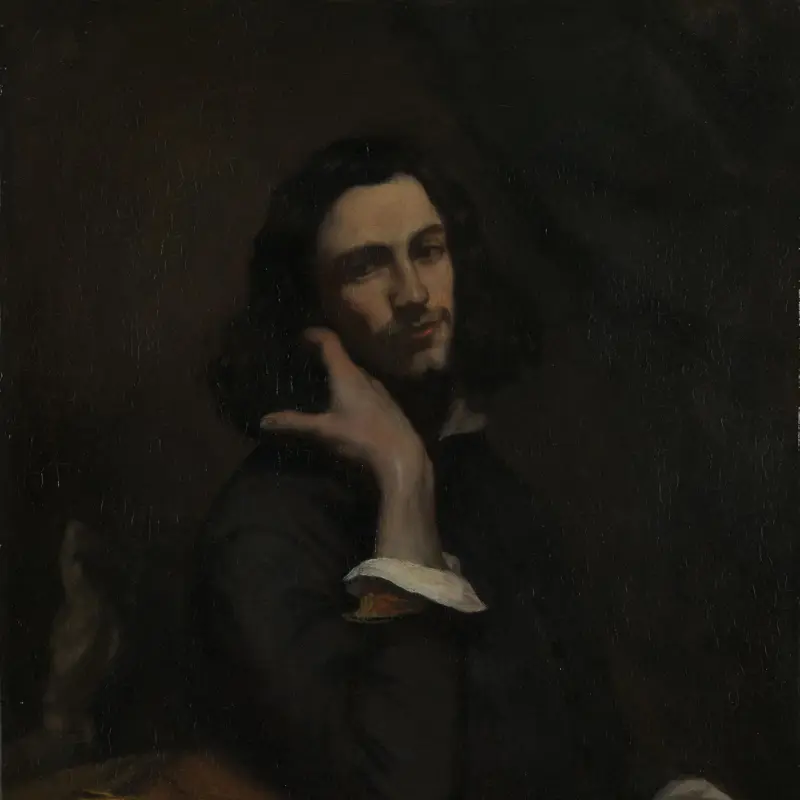Gustave Courbet, 'The Diligence in the Snow', 1860
About the work
Overview
The high viewpoint in this painting opens up the prospect of the vast distance, heightening its very real feeling of terror – yet the viewpoint also places us at a safe distance from the scene, without it losing its hold. The chaos of the overturned coach, the rearing horse and the bodies flailing about in the snow is matched only by the fear of the empty, impassive expanse of forest from which no help will come. Overhead the clouds darken and thicken; snow and yet more snow is on its way.
The white paint for the rocks and snow has been heaped on, smoothed or scraped back with a palette knife; the forest has been depicted with a dry brush drawn through a layer of black paint on white. Courbet painted several snow scenes and became an acknowledged master of the genre, capturing the light and brilliance of a landscape under snow.
Key facts
Details
- Full title
- The Diligence in the Snow
- Artist
- Gustave Courbet
- Artist dates
- 1819 - 1877
- Date made
- 1860
- Medium and support
- Oil on canvas
- Dimensions
- 137.2 × 199.1 cm
- Inscription summary
- Signed; Dated
- Acquisition credit
- Sir Hugh Lane Bequest, 1917, The National Gallery, London. In partnership with Hugh Lane Gallery, Dublin.
- Inventory number
- NG3242
- Location
- Not on display
- Collection
- Main Collection
Provenance
Additional information
Text extracted from the ‘Provenance’ section of the catalogue entry in Sarah Herring, ‘National Gallery Catalogues: The Nineteenth Century French Paintings’, vol. 1, ‘The Barbizon School’, London 2019; for further information, see the full catalogue entry.
Exhibition history
-
2006Long Loan to The Hugh Lane (2006 - 2019)Dublin City Gallery The Hugh Lane31 December 2006 - 18 April 2021
-
2021Long Loan to The Hugh Lane (2019 - 2031)Dublin City Gallery The Hugh Lane24 February 2021 - 23 February 2031
Bibliography
-
1860A. Tainturier, 'L'exposition de Besançon', Gazette des beaux-arts, 1860
-
1882P. Eudel, L'Hôtel Drouot et la curiosité en 1881 jusqu'en 1888, 9 vols, Paris 1882
-
1882École nationale supérieure des beaux-arts, Exposition des œuvres de G. Courbet à l'École des beaux-arts, Paris 1882
-
1906G. Riat, Gustave Courbet: Peintre, Paris 1906
-
1906L. Vauxcelles, 'Courbet at the Salon D'automme', Les Arts, 1906
-
1908
H.P. Lane, Illustrated Catalogue with Biographical and Critical Notes: Municipal Gallery of Modern Art, Dublin 1908
-
1929C. Léger, Courbet, Paris 1929
-
1932T. Bodkin, Hugh Lane and his Pictures, Dublin 1932
-
1957Martin Davies, National Gallery Catalogues: French School, 2nd edn (revised), London 1957
-
1970Davies, Martin, and Cecil Gould, National Gallery Catalogues: French School: Early 19th Century, Impressionists, Post-Impressionists etc., London 1970
-
1973J. Lindsay, Gustave Courbet: His Life and Art, Bath 1973
-
1977R. Fernier, La vie et l'oeuvre de Gustave Courbet: Catalogue raisonné, 2 vols, Paris 1977
-
1978K. Herding and W. Hofmann, Courbet und Deutschland (exh. cat., Hamburger Kunsthalle, Hamburg; Städtische Galerie im Städelschen Kunstinstitut, Frankfurt am Main), Cologne 1978
-
1993Hugh Lane Municipal Gallery of Modern Art, Images and Insights (exh. cat., Hugh Lane Municipal Gallery of Modern Art, 26 November 1993 - 27 March 1994), Dublin 1993
-
1994C. Phillips, 'National Gallery, II: Sir Hugh Lane's Pictures', in J. House, Impressionism for England: Samuel Courtauld as Patron and Collector, London 1994
-
2001
C. Baker and T. Henry, The National Gallery: Complete Illustrated Catalogue, London 2001
-
2019Herring, Sarah, National Gallery Catalogues: The Nineteenth Century French Paintings, 1, The Barbizon School, London 2019
About this record
If you know more about this work or have spotted an error, please contact us. Please note that exhibition histories are listed from 2009 onwards. Bibliographies may not be complete; more comprehensive information is available in the National Gallery Library.








